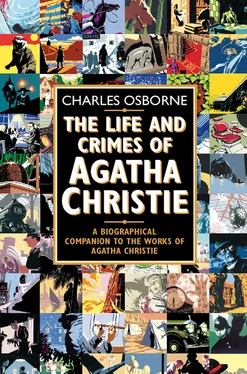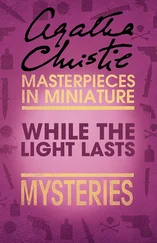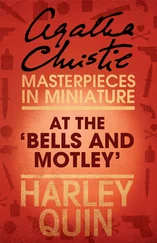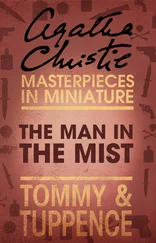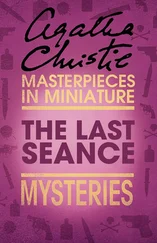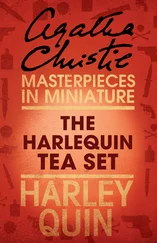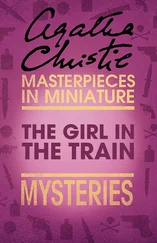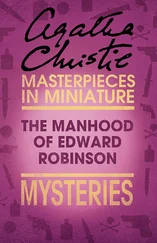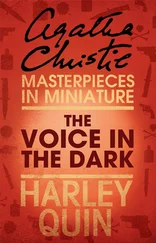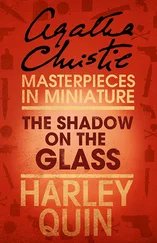POIROT (taking both her hands and kissing them): Un
de ces jours …
CARYL: What do you mean?
POIROT: Perhaps one day …
(Caryl goes out slowly. Poirot turns back to table, takes rose out of specimen glass which is on table, kisses it, and puts it in his button-hole, looking off towards the garden where Caryl has gone out.) The curtain falls.
The play, which was called Alibi, opened on 15 May 1928, at the Prince of Wales Theatre in the West End of London, with the twenty-nine-year-old Charles Laughton as Hercule Poirot, J. H. Roberts as Dr Sheppard, Basil Loder as Major Blunt, Henry Daniell (who went to Hollywood the following year to play suave villains in countless American films) as Parker, the butler, Lady Tree as Mrs Ackroyd, Jane Welsh as her daughter Flora, Cyril Nash as Ralph Paton, Henry Forbes Robertson as Geoffrey Raymond, Iris Noel as Ursula Bourne, and Gillian Lind as Caryl Sheppard. The Sketch said that Laughton ‘admirably impersonated’ Poirot, and Mrs Christie thought he was a good actor but ‘entirely unlike Hercule Poirot’. The play was a commercial success, running for 250 performances in London before being taken up elsewhere and eventually by amateur dramatic societies with whom it is still highly popular.
In 1931, the play became a film, still with the title of Alibi. Produced by Julius Hagen, who had already made an Agatha Christie movie in 1928 and directed by Leslie Hiscott, Alibi was filmed at the Twickenham studios near London, with Austin Trevor, who was even less like Hercule Poirot than Laughton had been, and who made no attempt at a characterization, but played the role ‘straight’. Others in the cast were Franklin Dyall, Elizabeth Allan, Clare Greet and Milton Rosmer. (Max Mallowan in his autobiography, Mallowan’s Memoirs, wrongly identifies the actor who played Poirot in this film as Francis Sullivan, who played Poirot twice on the stage, but who was not in either the film or the stage version of Alibi.)
Retitled The Fatal Alibi, the play was staged in New York on 28 February 1932, with Charles Laughton directing and also playing Poirot. It closed after twenty-four performances.
The first of Agatha Christie’s books to be produced in Great Britain by Collins and in America by Dodd, Mead & Co who had bought John Lane and Co, The Murder of Roger Ackroyd was published in the spring of 1926. Seven months later, on Friday, 3 December, Mrs Christie disappeared in mysterious circumstances worthy of one of her crime novels.
The year 1926 had been far from a happy one for Agatha Christie. It began well enough with a brief holiday in Corsica with her sister, during which she worked on The Mystery of the Blue Train, but shortly after the sisters arrived home they learned that their mother was ill and some months later Agatha found herself also having to cope with the realization that her marriage to Archie Christie had badly deteriorated. For some time Colonel Christie had seemed to be more interested in golf than in his wife, and now Agatha discovered that she had a more serious rival for her husband’s affections, a young woman called Nancy Neele who lived at Godalming in Surrey and who was also an acquaintance of hers. Archie confessed that he was in love with Miss Neele and wanted to marry her. He asked Agatha to divorce him.
On the morning of Friday, 3 December 1926, after a quarrel with his wife, Colonel Christie packed his bags and left home to spend the weekend with Miss Neele in Godalming. That evening, leaving her daughter Rosalind asleep in the house, Mrs Christie drove off in her car. She left two letters, one addressed to Archie, and one requesting her secretary to cancel her appointments as she was going to Yorkshire. According to the daughter of the then Deputy Chief Constable of Surrey, she posted a letter to the Deputy Chief Constable, in which she said she feared for her life, and appealed for his help. Her car was found next morning by George Best, a fifteen-year-old gypsy lad. It had been abandoned on the embankment at the side of the road at a popular ‘beauty spot’ called Newlands Corner, near a lake known as the Silent Pool. The bodywork of the car was covered in frost, and the lights were still on. Inside the car the police found a fur coat, and a small case which had burst open and which contained three dresses, two pairs of shoes and an expired driving licence in the name of Mrs Agatha Christie.
For the next few days the newspapers were full of stories about the well-known mystery writer’s disappearance, with huge banner headlines announcing new so-called developments, interviews with and comments by several people, and speculation by many more. Suicide was not ruled out, nor was murder.
On 7 December, the Daily News offered ‘£100 reward to the first person furnishing us with information leading to the whereabouts, if alive, of Mrs Christie’. The Deputy Chief Constable of Surrey said, in the best tradition of the detective novel: ‘I have handled many important cases during my career, but this is the most baffling mystery ever set me for solution.’ Also in the best tradition of crime fiction, suspicion centred for a time upon the husband of the missing woman.
By the following weekend, hundreds of policemen and thousands of members of the general public had joined in the search for Agatha Christie. The Silent Pool was dredged with special machinery, light aircraft scoured the countryside from above, and packs of airedales and bloodhounds went over the ground more closely. Police from four counties, Surrey, Essex, Berkshire and Kent, were brought in. As in an Agatha Christie murder mystery, a number of clues were found, only to be discarded as red herrings: a local chemist said that Mrs Christie had often discussed with him methods of committing suicide; a woman claimed that she had seen someone, whom she identified from photographs as Mrs Christie, wandering about, dazed; and two other people remembered that a woman answering to her description, her clothes covered in frost, had asked them the way to Petersfield, a town in Hampshire. The police guarded Colonel Christie’s house, monitored his phone calls, and followed him to his office. Christie told a city colleague, ‘They think I’ve murdered my wife.’ The weekend after her disappearance, in answer to an appeal from the police fifteen thousand volunteers searched the Downs. On the Saturday afternoon, three thousand of their cars were parked on Merrow Downs, and they set off in groups of thirty with a police officer in charge of each group. The Daily Mail played its part by publishing an article by the famous thriller writer, Edgar Wallace, in which he expounded his theory of Mrs Christie’s disappearance. He did not suspect foul play, but considered it
a typical case of ‘mental reprisal’ on somebody who has hurt her. To put it vulgarly her first intention seems to have been to ‘spite’ an unknown person who would be distressed by her disappearance.
That she did not contemplate suicide seems evident from the fact that she deliberately created an atmosphere of suicide by abandonment of her car.
Loss of memory, that is to say mental confusion, might easily have followed but a person so afflicted could not possibly escape notice … If Agatha Christie is not dead of shock and exposure within a limited radius of the place where her car was found, she must be alive and in full possession of her faculties, probably in London. It is impossible to lose your memory and find your way to a determined destination.
Edgar Wallace’s theory was perfectly tenable, and indeed in its essentials was correct. It was certainly quite proper for him to have suggested it, but perhaps unwise of the chief suspect, Colonel Christie, to put forward the same idea to the Daily News: ‘My wife said to me, some time ago, that she could disappear at will and would defy anyone to find her. This shows that the possibility of engineering her disappearance was running through her mind.’
Читать дальше
